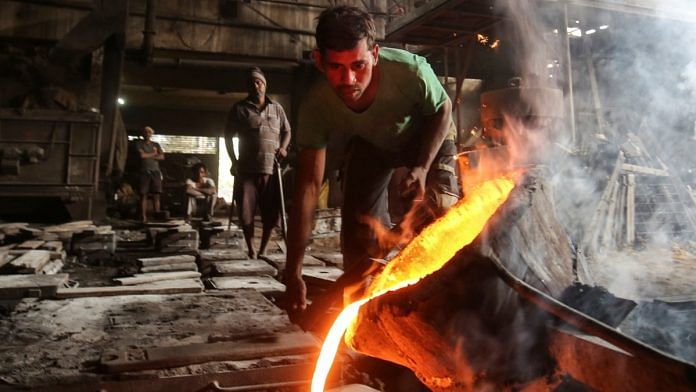Thank you dear subscribers, we are overwhelmed with your response.
Your Turn is a unique section from ThePrint featuring points of view from its subscribers. If you are a subscriber, have a point of view, please send it to us. If not, do subscribe here: https://theprint.in/subscribe/
India’s manufacturing sector is a significant part of the country’s economy, and the government is working to grow it. The sector employs millions of workers and contributes 13% to the GDP. According to recent data, India’s manufacturing production has shown a consistent increase over the last three years, with a growth rate of around 3% in December 2024 compared to the previous year; this is considered average compared to historical data, reaching a high of 196% in April 2021 and a low of -66.6% in April 2020 during the pandemic period. Manufacturing production in India averaged around 5.74% from 2006 until December 2024. As Share of global output in manufacturing, India’s is only 2.87% compared with China’s 31.63% and 15.87% of the US.
Manufacturing activity in India is increasing across a number of industries, including electronics, automotive, textiles, and pharmaceuticals. India is positioned as a critical node in the developing supply chain networks due to its advantageous geographic position, which includes access to important global markets and proximity to Southeast Asia. More international firms and MNCs are willing to expand their geographic presence and diversify their upstream and downstream sourcing partners
Unfortunately, India is not yet ready to exploit this opportunities to expand its manufacturing activities. There are still a number of issues to be resolved; some of these are regulatory complexity, skill shortages, land acquisition and building norms, and logistics and infrastructure impediments. India also does not have an acceptable accelerated dispute settlement mechanism. The Government of India is working with industry stakeholders to accelerate infrastructure modernization, streamline procedures, and make doing business easier. But the pace today is excruciatingly slow.
India’s challenges
The manufacturing countries in the Asia-Pacific regions are Vietnam, Malaysia, Thailand and India. While Vietnam contributes 25%, Malaysia 24% and Thailand 30%, the manufacturing sector’s contribution to India’s economy is still comparatively low, coming in at 15 percent in 2023 after having stagnated in the range of 13-17 percent for more than 20 years. But as of 2020, India’s Ease of Doing Business ranking has risen significantly to 63. The manufacturing industry brought in around US$21.34 billion in investment in FY22. In the coming years, FDI inflows into manufacturing are expected to rise as a result of the policy drive to improve the industry through the Production-Linked Incentives plan. Here again, India has not endeared itself to FDI in regard to ease of doing business.
Labor costs: South Asian countries such as Vietnam, Malaysia, Bangladesh, Indonesia, China, etc. offer more lucrative and competitive labor costs than India.
Infrastructure: Countries like Vietnam are concentrating on developing their manufacturing and construction sectors in order to boost their economies. Its edge in excellent infrastructure contributed to the 6.28 percent growth in the manufacturing sector. Although India’s central government did announce an increase in infrastructure spending in February 2024, the country’s manufacturing infrastructure has not yet undergone any structural transformations.
India’s advantages
Market size: India’s current manufacturing size is that of leading countries such as Vietnam and Malaysia.
Manufacturing activity in India is increasing across a number of industries, including electronics, automotive, textiles, and pharmaceuticals, as more international firms and MNCs feel compelled to spread their geographic presence and diversify their upstream and downstream sourcing partners.
India is positioned as a critical node in the developing supply chain networks due to its advantageous geographic position, which includes access to important global markets and proximity to Southeast Asia.
Defense sector
India has long been the largest importer in the world of defense equipment. Building a defense manufacturing base in India will be good for the economy to close the gap in balance of payment, save foreign currency, provide jobs and enhance self reliance.
Here are three areas where India needs to concentrate to enhance manufacturing
- Focus on strategic sectors:
Identifying and prioritizing high-potential sectors like electronics, pharmaceuticals, renewable energy, and automotive components for targeted investment and policy support.
- International collaborations:
Partnering with multinational corporations to access advanced technologies, expertise, and global market access through joint ventures or technology transfer agreements.
- Innovation ecosystem:
Encouraging research and development activities, supporting startups, and providing incubation centers to foster innovation and acquire new technologies within the manufacturing sector.
Tailpiece: For all of the manufacturing sector to come together it is imperative that the private sector makes substantial investments in cutting edge technologies. The industry must also make for the local markets like make shirts costing between Rs 300-500 rather than make only those that cost more than Rs. 3000. There is a large domestic market waiting to be exploited.
(The author is an Indian Army veteran and a contemporary affairs commentator. The views are personal.)
These pieces are being published as they have been received – they have not been edited/fact-checked by ThePrint.


